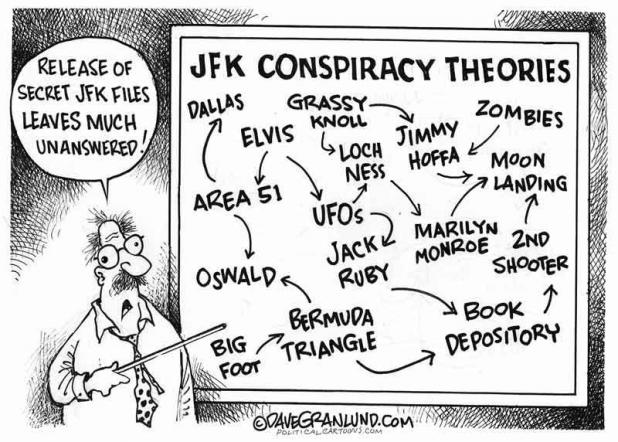
From the editor: At last, the truth about JFK will come out (possibly)
The Pentagon papers. Watergate. No arms-for-hostages deal with Iran.
“Read my lips.” “I did not have sex with that woman.” Weapons of mass destruction.
You can keep your health plan. Mexico will pay for the wall.
Heaven knows we’ve had reasons to mistrust what our leaders in Washington tell us. But there was one specific day when we turned from a nation of naïve believers into cantankerous skeptics, all in the time it takes to fire three rifle shots.
Or four shots. Or four to seven. From a book warehouse. Or a government office building. Or a sewer grate. Or a grassy knoll.
The day was Nov. 22, 1963, in Dallas, when President John F. Kennedy was assassinated. That single sentence contains every undisputed fact about the killing.
Everything else has been investigated, researched, doubted, supported, refuted, speculated about, and turned into dozens of theories and paranoid fantasies.
We may find out more Thursday. Under the terms of the President John F. Kennedy Assassination Records Collection Act of 1992, the federal government was required to release all unreleased records pertaining to the crime within 25 years. On Thursday, the 25 years are officially up.
The act was passed after the release of Oliver Stone’s movie “JFK,” which is a great entertainment but lousy history. It blurs the already blurry line between what we know and what some believe. But, nearly 30 years after the fact, the movie certainly refocused attention on history’s most complex and fascinating homicide.
Will we know more about the case after Thursday? Maybe. Don’t count on it.
A government conspiracy capable of covering up such an immense crime can probably come up with a way to light a match.
But we’re talking about all or part of more than 33,000 files and documents, according to press accounts. So maybe the evil geniuses missed something.
As you might suspect, something so vast and far-reaching, with a whiff of scandal and corruption, must have a Louisiana connection. And it does — several connections, in fact.
Lee Harvey Oswald, the man who the Warren Commission said killed the president while acting alone, was raised in New Orleans, more or less.
The commission was appointed by President Lyndon Johnson to investigate the assassination, with Chief Justice Earl Warren as the chairman. The commission failed to put suspicions to rest.
In 1967, Jim Garrison, then the district attorney in Orleans Parish, charged New Orleans businessman Clay Shaw with being one of the alleged conspirators. That prosecution provided the narrative backbone for “JFK.”
In real life, Garrison’s case was, to put it gently, thin. Garrison’s argument rested on a heroin addict, another man who thought LSU had replaced his daughter with an imposter, and repeated showings of the Zapruder film of the assassination.
Abraham Zapruder’s home movie of the shooting is compelling and disturbing, but Shaw doesn’t appear in it.
New Orleans mob boss Carlos Marcello was deported at the behest of Attorney General Robert F. Kennedy, the president’s brother. “JFK” refers to gun-running out of Morgan City, part of the effort to train and arm anti-Castro insurgents in Cuba.
The president’s move to shut down that training, and the attorney general’s crusade against organized crime, are often cited as motives for anti-JFK conspiracies.
Extreme anti-communists Guy Banister and David Ferrie, whom “JFK” connects with the assassination, were denizens of New Orleans.
Rose Cherami, a junkie and prostitute from Eunice, was hit by a car on U.S. 190 near that city in 1963. According to assassination lore, Cherami was being taken from Florida to Dallas by two men on a trip for drugs. She told a state police lieutenant that they threw her from their car after they told her they were going to kill Kennedy.
That was Nov. 20, two days before Kennedy’s assassination.
U.S. Rep. Hale Boggs, a New Orleans Democrat, sat on the Warren Commission. Eight years later, the small plane in which Boggs was a passenger disappeared somewhere in Alaska.
He became one of a string of people who died in mysterious circumstances linked by some researchers to the assassination. You can add Cherami, Ferrie and Banister to that list, too.
Whatever we find out when those records are released Thursday, don’t be surprised if researchers find a “Geaux Tigers” pennant, a recipe for etouffee and other Louisiana connections we haven’t dreamed of yet.
Bill Decker is managing editor of The Daily Review. Reach him at bdecker@daily-review.com.
